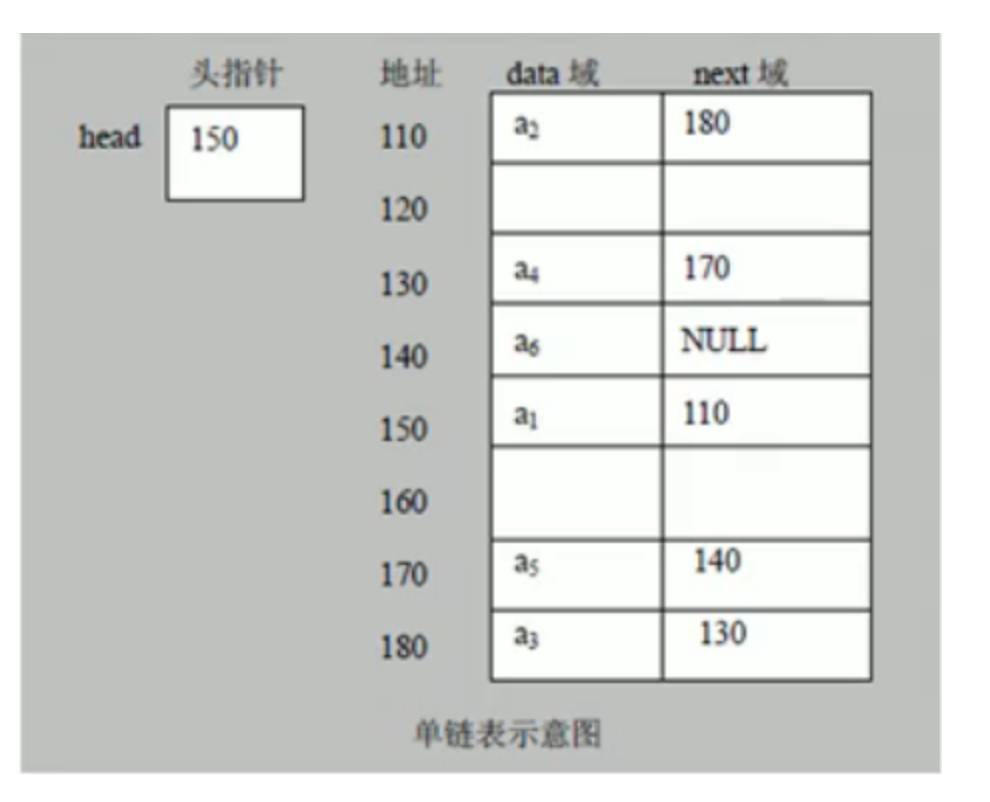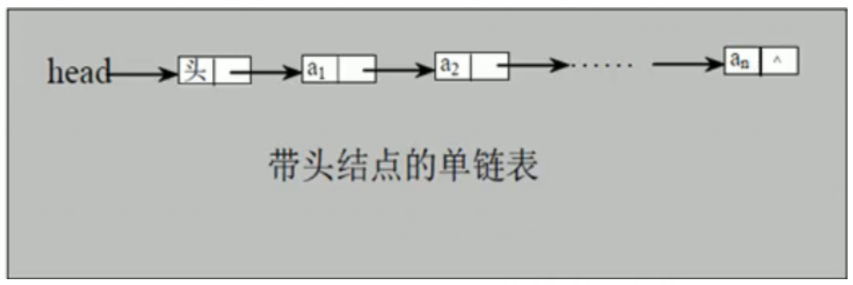基本介绍
链表是有序的列表,但是它在内存中存储如下

- 链表是以节点的方式来存储.
- 每个节点包含data域,next域:指向下一个节点.
- 如图:发现每个链表的各个节点不一定是连续存储
- 链表分带头节点的链表和没有头节点的链表,根据实际的需求来确定.
单链表介绍
单链表(带头节点)逻辑结构示意图如下

单链表的应用实例
使用带head头的单向链表实现-水浒英雄排行榜管理
- package com.structures.linkedlist;
- public class SingleLinkedListDemo {
- public static void main(String[] args) {
- HeroNode heroNode1 = new HeroNode(1, "宋江", "及时雨");
- HeroNode heroNode2 = new HeroNode(2, "卢俊义", "玉麒麟");
- HeroNode heroNode3 = new HeroNode(3, "吴用", "智多星");
- HeroNode heroNode4 = new HeroNode(4, "林冲", "豹子头");
- SingleLinkedList singleLinkedList = new SingleLinkedList();
- singleLinkedList.add(heroNode3);
- singleLinkedList.add(heroNode2);
- singleLinkedList.add(heroNode4);
- singleLinkedList.add(heroNode1);
- singleLinkedList.list();
- }
- }
- //定义SingleLinkedList管理我们的英雄
- class SingleLinkedList {
- //先初始化一个头节点,头节点不能动,将来遍历用
- private HeroNode head = new HeroNode(0, "", "");
- //添加节点到单向链表
- //思路:当不考虑编号的顺序时
- //1. 找到当前链表的最后节点
- //2. 将最后这个节点的next域指向新的节点
- public void add(HeroNode node) {
- //因为head节点不能动,因此我们需要一个辅助遍历temp
- HeroNode temp = head;
- //遍历链表,找到最后
- while (temp.next != null) {
- //找到链表的最后
- //如果没有找到temp就后移
- temp = temp.next;
- }
- temp.next = node;
- }
- //显示链表[遍历]
- public void list() {
- //判断链表是否为空
- if (head.next == null) {
- System.out.println("链表为空");
- }
- //因为头节点不能动,因此我们需要一个辅助变量来遍历
- HeroNode temp = head.next;
- while (temp != null) {
- //判断是否到最后
- //输出节点的信息
- System.out.println(temp);
- //将temp后移
- temp = temp.next;
- }
- }
- }
- //定义一个HeroNode,每个HeroNode对象就是一个节点
- class HeroNode {
- public int no;
- public String name;
- public String nickName;
- public HeroNode next;//指向下一个节点
- //构造器
- public HeroNode(int no, String name, String nickName) {
- this.no = no;
- this.name = name;
- this.nickName = nickName;
- }
- public HeroNode getNext() {
- return next;
- }
- public void setNext(HeroNode next) {
- this.next = next;
- }
- @Override
- public String toString() {
- return "HeroNode{" +
- "no=" + no +
- ", name='" + name + '\'' +
- ", nickName='" + nickName + '\'' +
- '}';
- }
- }
- /*
- HeroNode{no=3, name='吴用', nickName='智多星'}
- HeroNode{no=2, name='卢俊义', nickName='玉麒麟'}
- HeroNode{no=4, name='林冲', nickName='豹子头'}
- HeroNode{no=1, name='宋江', nickName='及时雨'}
- */
可以看到以上链表的实现方式,在添加英雄时,并未按照英雄的编号进行排序. 下面重新写一个添加方法,实现插入英雄时按编号排序
- package com.structures.linkedlist;
- public class SingleLinkedListDemo {
- public static void main(String[] args) {
- HeroNode heroNode1 = new HeroNode(1, "宋江", "及时雨");
- HeroNode heroNode2 = new HeroNode(2, "卢俊义", "玉麒麟");
- HeroNode heroNode3 = new HeroNode(3, "吴用", "智多星");
- HeroNode heroNode4 = new HeroNode(4, "林冲", "豹子头");
- SingleLinkedList singleLinkedList = new SingleLinkedList();
- singleLinkedList.addByNo(heroNode3);
- singleLinkedList.addByNo(heroNode2);
- singleLinkedList.addByNo(heroNode4);
- singleLinkedList.addByNo(heroNode1);
- singleLinkedList.list();
- }
- }
- //定义SingleLinkedList管理我们的英雄
- class SingleLinkedList {
- //先初始化一个头节点,头节点不能动,将来遍历用
- private HeroNode head = new HeroNode(0, "", "");
- //添加节点到单向链表
- //思路:当不考虑编号的顺序时
- //1. 找到当前链表的最后节点
- //2. 将最后这个节点的next域指向新的节点
- public void add(HeroNode node) {
- //因为head节点不能动,因此我们需要一个辅助遍历temp
- HeroNode temp = head;
- //遍历链表,找到最后
- while (temp.next != null) {
- //找到链表的最后
- //如果没有找到temp就后移
- temp = temp.next;
- }
- temp.next = node;
- }
- //第二种添加英雄的方式,在添加英雄时,根据排名将英雄插入到指定位置
- //如果有这个排名,则添加失败,并给出提示
- public void addByNo(HeroNode heroNode) {
- //因为head节点不能动,因此我们需要一个辅助遍历temp
- //因为单链表,因此找的temp是位于添加位置的前一个节点,否则加入不了
- HeroNode temp = head;
- boolean flag = false;//标识添加的编号是否存在,默认false
- while (true) {
- if (temp.next == null) {
- break;
- }
- if (temp.next.no > heroNode.no) {//位置找到,就在temp的后面插入
- break;
- } else if (temp.next.no == heroNode.no) {
- //编号已存在
- flag = true;
- break;
- }
- temp = temp.next;
- }
- if (flag) {
- System.out.printf("准备插入的英雄的编号 %d 已存在,不能加入\n", heroNode.no);
- } else {
- //插入链表temp的后面
- heroNode.next = temp.next;
- temp.next = heroNode;
- }
- }
- //显示链表[遍历]
- public void list() {
- //判断链表是否为空
- if (head.next == null) {
- System.out.println("链表为空");
- }
- //因为头节点不能动,因此我们需要一个辅助变量来遍历
- HeroNode temp = head.next;
- while (temp != null) {
- //判断是否到最后
- //输出节点的信息
- System.out.println(temp);
- //将temp后移
- temp = temp.next;
- }
- }
- }
- //定义一个HeroNode,每个HeroNode对象就是一个节点
- class HeroNode {
- public int no;
- public String name;
- public String nickName;
- public HeroNode next;//指向下一个节点
- //构造器
- public HeroNode(int no, String name, String nickName) {
- this.no = no;
- this.name = name;
- this.nickName = nickName;
- }
- public HeroNode getNext() {
- return next;
- }
- public void setNext(HeroNode next) {
- this.next = next;
- }
- @Override
- public String toString() {
- return "HeroNode{" +
- "no=" + no +
- ", name='" + name + '\'' +
- ", nickName='" + nickName + '\'' +
- '}';
- }
- }
- /*
- HeroNode{no=1, name='宋江', nickName='及时雨'}
- HeroNode{no=2, name='卢俊义', nickName='玉麒麟'}
- HeroNode{no=3, name='吴用', nickName='智多星'}
- HeroNode{no=4, name='林冲', nickName='豹子头'}
- */
再次进行完善功能,添加修改节点功能
- //修改节点的信息,根据no编号来修改,即编号no不能修改.
- public void update(HeroNode heroNode) {
- //判断是否为空
- if (head.next == null) {
- System.out.println("链表为空");
- }
- //找到需要修改的节点,根据no编号
- HeroNode temp = head.next;
- boolean flag = false;//表示节点是否找到
- while (true) {
- if (temp == null) {
- break;
- }
- if (temp.no == heroNode.no) {
- flag = true;
- break;
- }
- temp = temp.next;
- }
- if (flag) {
- temp.name = heroNode.name;
- temp.nickName = heroNode.nickName;
- } else {
- System.out.printf("没有找到 编号%d 的节点,不能修改\n", heroNode.no);
- }
- }
再次进行完善功能,添加删除节点功能
- //删除节点
- public void remove(HeroNode heroNode) {
- //判断是否为空
- if (head.next == null) {
- System.out.println("链表为空");
- }
- HeroNode temp = head.next;
- boolean flag = false;//标识是否找到待删除的点
- while (true) {
- if (temp == null) {
- break;
- }
- if (temp.next.no == heroNode.no) {
- flag = true;
- break;
- }
- temp = temp.next;
- }
- if (flag) {
- temp.next = temp.next.next;
- } else {
- System.out.printf("无法删除 编号%d 的节点,\n", heroNode.no);
- }
- }
再次进行完善功能,添加统计单链表的有效节点数功能
- /**
- * 获取单链表的有效节点数,不统计头节点
- * @param head 链表的头结点
- * @return 有效节点数
- */
- public static int getLength(HeroNode head) {
- if (head.next == null) {
- return 0;
- }
- int count = 0;
- HeroNode temp = head.next;
- while (temp.next != null) {
- count++;
- temp = temp.next;
- }
- return count;
- }
再次进行完善功能,添加查找单链表中的倒数第K个节点功能
- /**
- * 查找单链表的倒数第K个节点[新浪面试题]
- * 思路:
- * 1.先把链表从头到尾遍历,得到链表的总长度
- * 2.得到size后,从链表的第一个开始遍历到(size-index)个,就可以得到
- *
- * @param head
- * @param index 表示倒数第index个节点
- * @return
- */
- public static HeroNode findLastIndexNode(HeroNode head, int index) {
- if (head.next == null) {
- return null;
- }
- int size = getLength(head);
- if (index <= 0 || index > size) {
- return null;
- }
- HeroNode temp = head.next;
- for (int i = 0; i < (size - index); i++) {
- temp = temp.next;
- }
- return temp;
- }
再次进行完善功能,添加单链表反转功能
- /**
- * 反转链表[腾讯面试题]
- * 思路:
- * 1.先定义一个reverseHead = new HeroHead();
- * 2.从头到尾遍历原来的链表,每遍历一个节点,就将其取出,并放在新的链表的最前端;
- * 3.原来的链表的head.next = reverseHead.next;
- */
- public static void reverseList(HeroNode head) {
- if (head.next == null || head.next.next == null) {
- return;
- }
- HeroNode curr = head.next;
- HeroNode next = null;//指向当前节点[curr]的下一个节点
- HeroNode reverseHead = new HeroNode(0, "", "");
- while (curr != null) {
- next = curr.next;//先暂时保存curr节点的下一个节点
- curr.next = reverseHead.next;//将curr的下一个节点指向新的链表的最前端
- reverseHead.next = curr;//将curr连接到新的链表上
- curr = next;//让curr后移
- }
- head.next = reverseHead.next;
- }
再次进行完善功能,添加从尾到头打印单链表功能
- /**
- * 使用栈的方式逆序打印[百度面试题]
- */
- public static void reversePrint(HeroNode head) {
- if (head.next == null) {
- return;
- }
- Stack<HeroNode> heroNodes = new Stack<HeroNode>();
- HeroNode temp = head.next;
- while (temp != null) {
- heroNodes.add(temp);
- temp = temp.next;
- }
- while (heroNodes.size() > 0) {
- System.out.println(heroNodes.pop());
- }
- }
【编辑推荐】



























